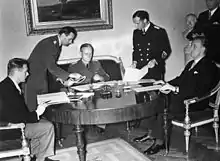German–Estonian Non-Aggression Pact
The German–Estonian Non-Aggression Pact was signed in Berlin on June 7, 1939, by Estonian and German Foreign Ministers Karl Selter and Joachim von Ribbentrop. The German–Latvian Non-Aggression Pact was also signed on the same day. Ratifications of the German-Estonian Pact were exchanged in Berlin on July 24, 1939, and it became effective the same day. It was registered in League of Nations Treaty Series on August 12, 1939.[1] The pact was intended for a period of ten years.

The pacts were intended to prevent the West or the Soviets from gaining influence in the Baltic states and thus encircling Germany.[2] A non-aggression pact with Lithuania was concluded in March after the 1939 German ultimatum to Lithuania regarding the Klaipėda Region. The states were to provide a barrier against any Soviet intervention in a planned German–Polish war.[2]
Germany offered to sign non-aggression pacts with Estonia, Latvia, Finland, Denmark, Norway and Sweden on April 28, 1939.[3] Sweden, Norway and Finland rejected the proposal. The first drafts were prepared the first week of May, but the signing of the treaties was twice delayed by Latvia's requests for clarification.[3]
References
- League of Nations Treaty Series, vol. 198, pp. 50-53.
- Crampton, R. J. (1997). Eastern Europe in the Twentieth Century and After. Routledge. pp. 105. ISBN 0-415-16422-2.
- John Hiden, Thomas Lane, ed. (2003). The Baltic and the Outbreak of the Second World War. Cambridge University Press. p. 60. ISBN 0-521-53120-9.